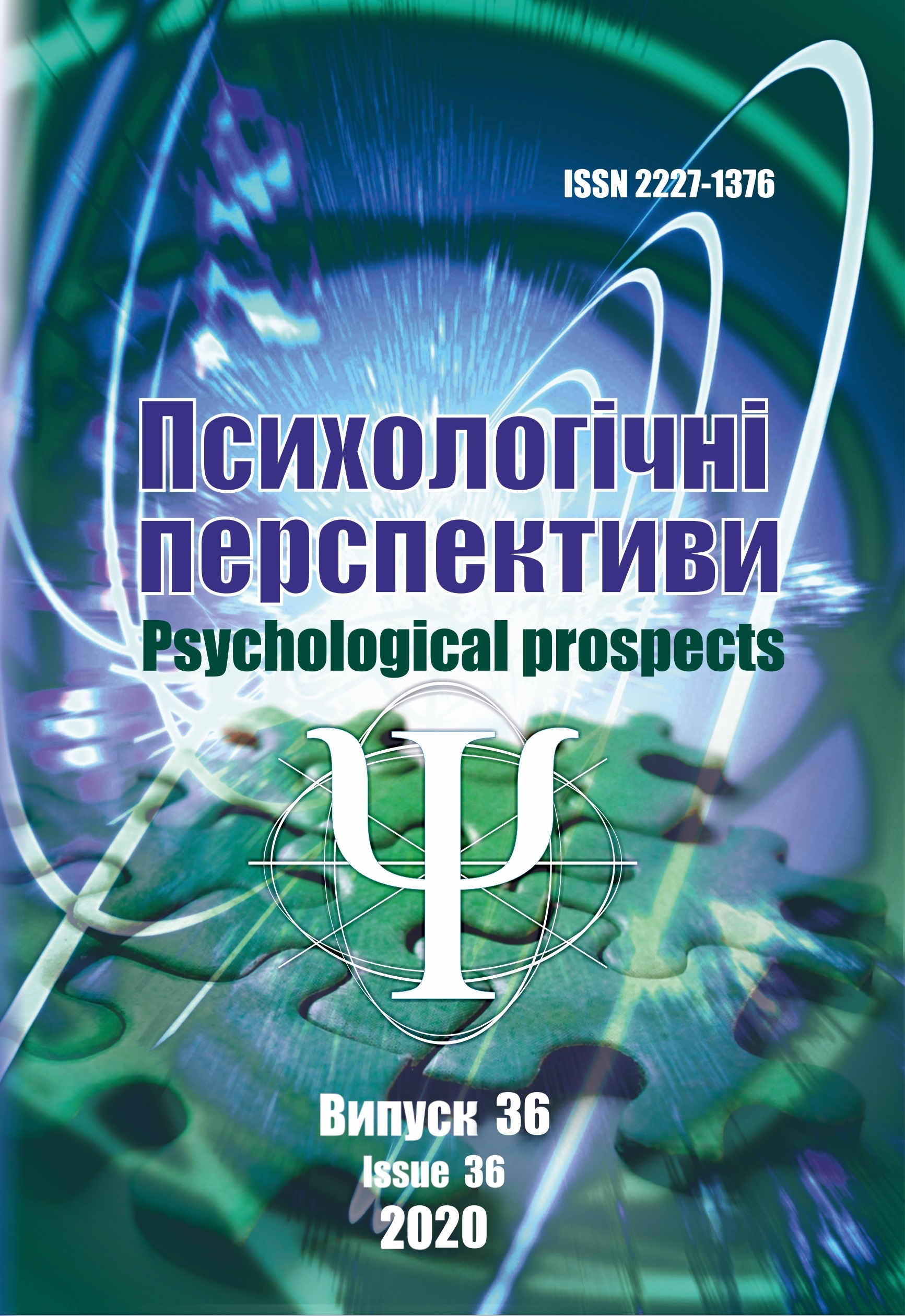The research of dominant fears in children with cancerous conditions at different stages of treatment
DOI:
https://doi.org/10.29038/2227-1376-2020-36-189-207Keywords:
hematological malignancies, primary school age, psychological peculiaritiesAbstract
Purpose. The present article provides the research results of fear in primary school-aged children who suffer from hematologic malignancies. It is performed a benchmarking analysis of gender differences of dominant fears in children with hematological malignancies, fulfilled a comparative study of fears in three samples of cancerous patients. The goal of the research is investigation of prevalent fears in children with cancer diagnosis at different stages of treatment. Methods. For performing the tasks of studying children’s fears, the methodology of O.I.Zakharov was applied with the involvement of such processing results methods as comparative analysis (Student's t-test) and one-way analysis of variance (Scheff's criterion). Results. Based on the results of the conducted research it is estimated that cancer-affected girls are characterized by the presence of medical fears, fears of animals, fears of fabulous (fantastic) characters, fear of own death, fear of parents’ death, fear of nightmares, and fears associated with falling asleep. For studied boys with cancer diagnosis it is common to be afraid of physical injures and space fears. It is asserted distinctive dominant fears in cancer pediatric patients with different lengths of hospital stay according to the methodology scale of children’s fears identification. It is established distinctive dominant fears in children with malignancies and relatively healthy children from the control group. It is identified statistically significant discrepancy according to the methodology scale of children’s fears identification between cancer-affected children under study with the experience of transplantation and other patients from the study group as well as difference between the children under study who achieved remission and the ones who have not achieved disease regression yet. Conclusions. According to the conducted research, it is estimated that children with hematological malignancies and relatively healthy children from the control group are characterized by distinctive dominant fears. Ultimately, it is possible to elicit that dominant fears in children with hematological malignancies significantly differ depending on the stage of treatment and these fears are tightly connected with individual (personal) experience of the disease.References
Binnebezel, H. Katolyk. (Ed.). (2018) Paliatyvno-khospisna opika: pozamedychni bahatovymirni aspekty [Palliative-hospice care: extra-medical multidimensional aspects]. Lviv: Ukrainian Catholic University. NowaWies: Vydavnitstno Rolevski [in Ukrainian].
Birjukova I.A (2018) Psihologicheskie osobiennosti detej, stradajushchih onkozabolievanijami [Psyhologial features of children with cancer]. Izvestija vysshih uchebnyh zavedenij. Ural'skijregion - Proceedings of higher educational institutions. Ural region, 1, 107-112, Cheljabinsk: IzLiT. [in Russian].
Zakharov A.I.(2000). Dnevnye i nochnye strakhi u detei [Children’s Daytime and Night Fears]. Sankt-Peterburg: Soiuz, [in Russian].
Isaev D.N. (2004). Detskaya meditsinskaya psikhologiya. Psikhologicheskay pediatriya [Children’s medical psychology. Psychological pediatrics]. Sankt- Peterburg: Rech Publ. [in Russian].
Katolyk H. V., Stulkivska М.М (2020) Spryiniattia ditmy smerti: vikovi ta boliovi aspekty. [Children's perception of death: age and pain aspects]. Sotsialno-pravovi studii - Socio-legal studies, 2(8), 210-217. DOI: https://doi.org/10.32518/2617-4162-2020-2-210-217 [in Ukrainian].
Kyjan I.K. (2003) Lichnostnye osobennosti detej, stradaiushchih ostrym limfoblastnym leikotsytozom..[Personal characteristics of children with a cute lymphoblastic leukocytosis]. Extended abstract of candidate’s thesis. Rossijskij gosudarstvennyj medicinskij unіversitet [in Russian].
Kurtanova Yu.E., Burdukova Yu.A., Shcherbakova A.M, Shchuckina V.D.,&Ivanova A.A. (2020) Social'naja adaptacija detej s onkologicheskimi zabolevanijami [Social adaptation of children with cancer after prolonged treatment]. Еlektronnyj zhurnal, Sovremennaja zarubezhnaja psihologija - Electronic journal, Contemporary foreign psychology, 9(3), 127-138. DOI: https://doi.org/10.17759/jmfp.2020090312 [in Russian].
Skakovska A.V.(2019) Vyvchennia neverbalnyh strahiv u ditei z onkohematolohichnymy zahvoriuvanniamy. [Study of nonverbal fears in children with oncohematological diseases] Kyivskyi naukovo-pedahohichnyi visnyk – Kyiv Scientific and pedagogical bulletin, 18, 116 -120 [in Ukrainian].
Skakovska A.V. (2020). Doslidzhennia koreliatsiinoho zviazku strahiv ta yakostei osobystosti u ditei z onkolohichnymy zahvoriuvanniamy. [A study of the correlation between fears and personality traits in children with cancer] Materialy II naukovo- praktychnoi konferentsii «Humanitarni ta pryrodnychi nauky: aktualni pytannia», (pp.122-126) Dnipro [in Ukrainian].
Shats I.K. (2016). Bolnoi rebenok i ego semya: formy i vozmozhnosti psikhologicheskoi pomoshchi [A sick child and his family: the forms and possibilities of psychological help]. St. Petersburg: SpetsLit Publ. [in Russian].
Binnebesel J. (2000) Opieka nad dzhetskem z khorobou novotvorovoun. Aspekt pozamedychny [Caring for a child with cancer. Non-medical aspect]. Torun’: Vydavnitstvo naukove universytetu Mikolaya Kopernika [in Polish].
Guralchyk E. (1996). Khoroba dzhetska v tvoim zhychu. [Child's disease in your life.]. Warshava : Tsentrum Metodychne Pomotsy Psyhologichno- Pedagogichnei Ministerstva Edukatsii Narodovei [in Polish].
Guralchyk E. (2009). Dzhetsko pshevlekve khore. Psyhologichne aspekty funktsionovania dzhetska v shkolie i pshedshkolie [Chronic sick child. Psychological aspects of a child's functioning at school and kindergarten]. Warshava: Tsentrum Metodychne Pomotsy Psyhologichno-Pedagogichnei v Warshavie [in Polish].
Varni J. W., Katz E. R., Colegrove R. Jr., Dolging M. (1995). Perceived physical appearance and adjustmen with newly, diagnosed cancer; a path anlytic model, J. Behav. Med. (J58), Jun. 18 (3).
Shlepovronska D., (1989), Opotszhebe badania vedzy potochnei dzheti dotychontsei shmerti [About the need to study the common knowledge of children about death]. Psyhologiia Vyhovavcha – Psychology of Education, 2 (3), Lvuv-Warshawa. [in Polish].
Downloads
Published
Issue
Section
License
Copyright (c) 2020 Skakovska Anastasiia

This work is licensed under a Creative Commons Attribution-NonCommercial 4.0 International License.






